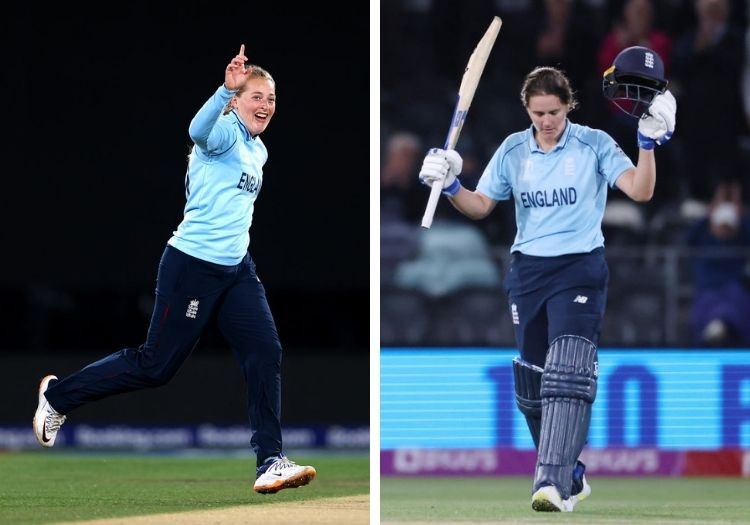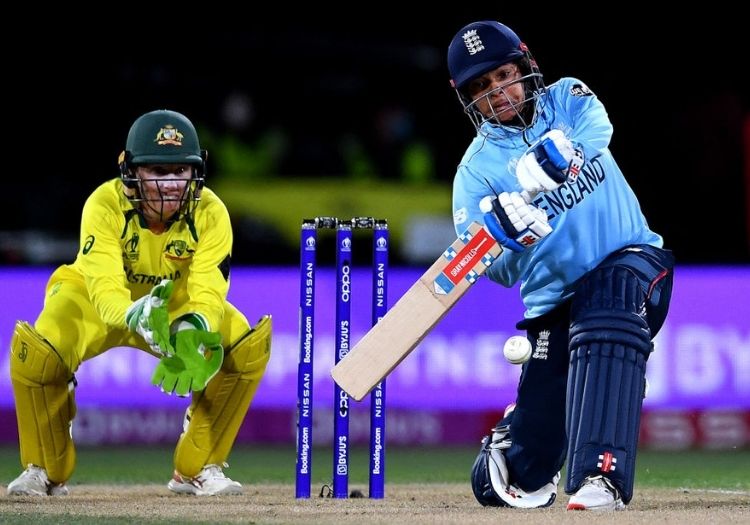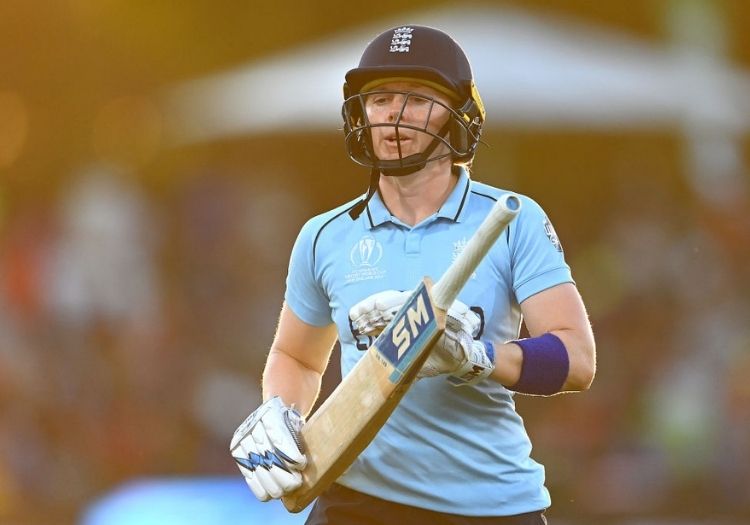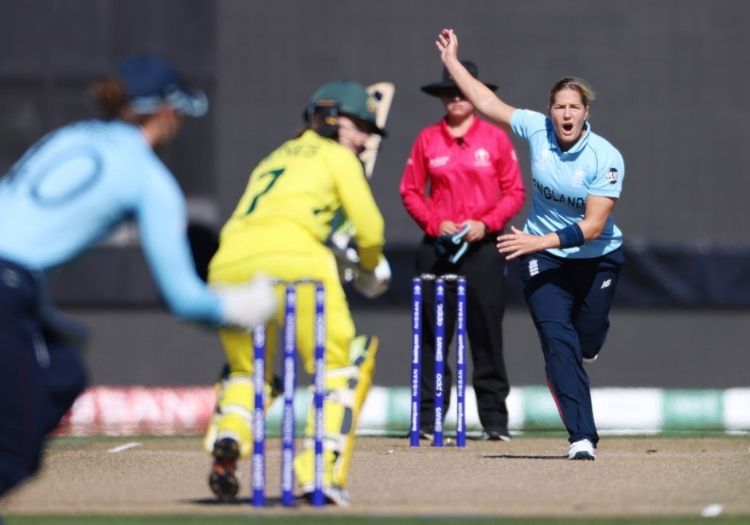NICK FRIEND casts his eye over the performances during England's 2022 Women's World Cup campaign

Nat Sciver (436 runs at 72.66, 4 wickets at 73.75)
If you'd told Sciver that she would make two brilliant unbeaten centuries against Australia at better than a run a ball, she might have hoped to have been on the winning side. Instead, both knocks – each world-class in their own way – came in a losing cause. Australia's admiration was clear: Matthew Mott applauded in the final and namechecked her in his team's celebratory team talk, while Meg Lanning raved in her press conference.
She added another half century against New Zealand, though got out at a crucial moment that almost led to a winter-defining defeat – her propensity to not see things through was visible in wins over Bangladesh and India as well. She looked in excellent touch throughout, though. With the ball, she was less impressive: unthreatening for the most part and England's most expensive bowler. A-
Sophia Dunkley (291 runs at 36.37)
Dunkley came into this tournament not so much with a point to prove as a position to nail down. Her ODI career began impressively last summer with a match-clinching knock to beat India, but she faded thereafter in a traditionally difficult position at No.6. With Amy Jones misfiring directly above her and the opening spot becoming a regular discussion point, Dunkley was more often fighting fires and rebuilding than putting the finishing touches to strong platforms. It was, therefore, a terrific effort to end the tournament with a lowest score of 17.
She upped the ante every time she came to the crease and was unafraid to take risks. At one point, she was frustrated with her own profligacy once well set – she made 28, 38, 26, 17 and 33 in her first five innings without going on – but half centuries against Bangladesh and South Africa showed a player maturing on the biggest stage. B+

Sophia Dunkley [Sanka Vidanagama/Getty Images]
Danni Wyatt (271 runs at 33.87)
A curious tournament for Wyatt, which leaves England more or less where they started ahead of the winter: without a settled opening partner for Tammy Beaumont. A match-winning hundred against South Africa in the semi-final showed the upside to making their T20 opener their ODI opener. She was more selective than usual and played perhaps the most skilful knock of her career, having lost Beaumont early on. She was similarly fluent against Pakistan, belting an unbeaten 76 as England raced to a paltry target.
The question, though, remains this: is this the long-term answer? The smart money suggests not, if only because Wyatt's long-term record – albeit having been moved all over the order – suggests that consistency has never been a strong point. Her promotion also made England weaker at No.7, where she appeared to have found a niche as finisher-in-chief. Instead, Katherine Brunt slotted in and the team looked a batter light. It's a difficult dilemma, with supporting factors for both (and she has publicly said she enjoys opening), but Wyatt's future role needs sorting – for her own focus as much as anything else. B
Tammy Beaumont (277 runs at 30.77)
Such are Beaumont's high standards in ODI cricket, this World Cup ranks as a minor disappointment for the 2017 player of the tournament. She was less expressive than in the past, scoring slower than all apart from Jones, Lauren Winfield-Hill and Anya Shrubsole. Part of that was down to her role as England's anchor, while she was further hindered by the regular fall of early wickets.
She began perfectly well as one of England's few consistent performers in the defeats by Australia (74), West Indies (46) and South Africa (62). But she fell away from there, never passing 33 in her next six innings, with opposition bowlers exploiting her propensity to get stuck behind the ball, a technical issue that meant she was susceptible to being trapped in front – a flaw best displayed in the final, when Megan Schutt took advantage. Mediocre returns shouldn't cloud anyone's judgement, however; she remains one of the world's leading batters. B

Danni Wyatt [Hannah Peters/Getty Images]
Heather Knight (206 runs at 29.42, 2 wickets at 36)
In the context of the World Cup, perhaps Knight's winter peaked too early in the drawn Ashes Test, when she played a knock that she will struggle to match through the rest of her career. There was a single half century against India – crucial in the end as wickets tumbled around her as the finishing line came into view – but that was just about the extent of her defining contributions with the bat.
She made starts against Australia twice (40 in their tournament opener, 26 in the final) and hit 42 in the win over New Zealand. Despite looking in decent touch throughout, she couldn't go on. She found herself tied down at times, unable to properly cut loose – as in the semi-final against South Africa.
As captain, however, her performance was so fundamental to England's recovery that to debate her decision at the toss in the final would rather miss the point. Without the calmness of her leadership at a time when it would have been easy not to be so composed, quite simply England wouldn't have made it to the end. At the end of a desperately long winter, that quality should not go overlooked. B-
Sophie Ecclestone (98 runs at 24.50, 21 wickets at 15.61)
The ICC's rankings are often – and justifiably – panned as nonsensical and arbitrary. But they've got it spot on in their assessment of Ecclestone as the world's leading bowler. Still just 22 years of age, her World Cup record – of 21 wickets at 15.61 apiece – is every bit as outrageous as it sounds but perhaps still secondary to her fear factor, that meant every team – barring Australia – were content to simply attempt survival.
Domestic players have long planned for facing the left-arm spinner by putting away their cut shot, in the knowledge that her greatest asset is not so much her spin as her pace and bounce, meaning that opening up the off-side risks giving Ecclestone a glimpse of your stumps. Her six-wicket haul against South Africa was the crowning glory – somehow the first time she had picked up more than four wickets in her international career – but it was the spells against Pakistan, Bangladesh, India and South Africa (in the group stage) that were most impressive.
Typically, the only side that found a way past her threat were Australia, and their most alpha move in a tournament that saw them set further new standards might just have been in their takedown of Ecclestone. She conceded 180 runs in 65 overs against six countries, but 148 in 20 against the other. No doubt, figuring out that conundrum will be next on her list. A

Heather Knight [Hannah Peters/Getty Images]
Amy Jones (148 runs at 18.59)
A difficult tournament to judge for Jones, given her wicketkeeping, which so often slides under the radar when in fact – to this observer – it was one of the central pillars of England's revival. Having begun so poorly in the field, dropping catches all over the place and gifting extras at every corner, the calming presence of Jones behind the stumps was initially in direct contrast.
Standing up to the seamers, she was peerless, while she rode the bounce of Ecclestone impeccably and pouched excellent catches off Charlie Dean on both sides of the bat, including those more difficult chances when she beat the right-hander on the outside edge. Her status as the best keeper in the women's game was reinforced, even as Alyssa Healy took aim with the bat.
In that area, though, Jones' output was a concern. Stationed at No.5, England need more from her: she has two half centuries in her last 23 innings, one of which came in a rebuilding job against South Africa during the group stage. Otherwise, she contributed four low scores and three promising starts, in which she looked a million dollars. C+
Charlie Dean (27 runs at 13.50, 11 wickets at 18)
A massive positive for England was Dean's emergence as a high-class off-spinner and a genuine wicket-taking option through the middle overs. She took more wickets than Brunt and Sciver in a third of the overs, and it was her four-wicket spell against India that reignited her side's World Cup charge. She spun the ball on pitches that offered assistance and, more importantly, found a way of retaining her threat even when the pitches weren't in her favour. Her dismissal of Harmanpreet Kaur stands out in that regard: a delivery that drifted away from the right-hander and clipped her outside edge.
Like most in this squad, Australia had her measure and Healy gave her no chance to settle in the final. But at 21, those limitations can certainly be forgiven. She still made a contribution, though, supporting Sciver with vital runs at No.10 – a knock, through both her technique and mindset, that suggested she shouldn't ever bat so low again.
Most importantly, Dean's performances give credence to the new regional structure – while she was first developed at county level, it is with Southern Vipers under Charlotte Edwards that she has taken her game to this level. Others must follow suit. B+
Katherine Brunt (83 runs at 11.85, 4 wickets at 76)
Ever-willing and always attempting to improve, one wonders whether Brunt will play another ODI for England.
She has been a brilliant international cricketer and one of the all-time greats of the women's game, but the end is drawing near. She told The Cricketer in 2020 that one aim was to reach the Commonwealth Games later this summer, and perhaps that will represent a natural cut-off point. If England want to begin the rebuilding of an ageing team (no other country had so many players older than 30 at the World Cup) this summer, then it is hard to see how Brunt – even with her competitive spirit – can be a major part of that process, given the time between now and the next World Cup.

Katherine Brunt [Peter Meecham/Getty Images]
She began the tournament poorly, bowling too short and often too wide. After five games, she had only a single wicket – a wide drag-down that Lanning hammered to point – to show for her efforts, but it was to her immense credit that she took herself away to the nets and worked everything out, returning with three wickets against Pakistan, including one off the first ball of the match – swinging away and taking the edge to slip – that was entirely the kind of delivery that she didn't bowl enough of over the month.
With the bat, Brunt looked a place too high at No.7 and that became even more the case when Ecclestone, Dean and Kate Cross were batting beneath her and looking equally – if not more – accomplished. C
Kate Cross (37 runs at 9.25, 7 wickets at 45.71)
As so often in Cross' career, she bowled far better than her numbers suggested. Seven wickets at 45.71 apiece don't tell the whole story, and she was let down more than most by the early sloppiness in the field. For her part, by the way, she was exceptional in the field, often at mid-on. Her runout of Deepti Sharma was another catalyst for England's fightback. After New Zealand's strong start in a crucial win-or-bust encounter, it was Cross who knocked over Suzie Bates and Sophie Devine, albeit carrying an injury.
One senses – effectively faced with six knockout matches in a row – she is exactly the kind of cricketer you'd want by your side: wholehearted, committed and happy to get on with an unfashionable job through the middle overs. Like Brunt, she strayed too straight in the final and was expensive as a result, but overall this was a decent month for a seamer who's improving with age and now feels like an undroppable member of the side. B
Lauren Winfield-Hill (12 runs at 6)
Two games was all it took for England to make a change at the top of the order, with Winfield-Hill replaced by Wyatt and dropped in favour of an extra bowling option. She is without an international half century since 2016, but England persisted, perhaps influenced by the simple fact that she has looked like breaking that drought so often, only to lose her wicket when well set. In that regard, maybe it was fitting that her final action of the World Cup was being caught by Deandra Dottin in spectacular, unmatched style in the defeat by West Indies.
England took that as their cue for change. With Winfield-Hill not part of the T20 side, it isn't easy to see when her next international white-ball cricket will come. She played in the Test last year against India and did nothing then that would merit her losing her place for this summer's instalment with South Africa, but in ODI cricket her race might now be run. Emma Lamb and Eve Jones appear to be next in line, and whoever is given the chance must be given sufficient time to get to grips with the role. D

Lauren Winfield-Hill [Marty Melville/Getty Images]
Anya Shrubsole (10 runs at 5, 9 wickets at 29.66)
One of England's major issues through the tournament was a lack of early wickets. It cost them in the final, with Healy and Rachael Haynes primed by the end of the powerplay to cause carnage. And while Shrubsole was more potent than Brunt, her nine wickets were almost certainly fewer than had been hoped of one of the game's most prodigious swingers of the new ball.
At her best, she was excellent – and she was by far the pick of England's bowlers in the final, while also picking up two wickets in each of the group matches against South Africa and India. She reprised her performance against the Proteas in the semi-finals, dismissing Laura Wolvaardt without scoring and accounting once again Lizelle Lee.
Shrubsole, though, has struggled with injuries over the past couple of years and admitted to The Cricketer ahead of the World Cup that those difficulties had taken their toll. She was visibly emotional ahead of the final – a game in which, five years ago, she enjoyed her greatest day in the sport – and one wonders for how much longer she plans to go on. C+
Freya Davies (2 wickets at 18)
It wouldn't be fair to judge Davies on the strength of one performance against Bangladesh when she replaced Shrubsole so her workload could be managed. She is 26 now so could do with a prolonged run in the side as England begin to look to the future. C
Emma Lamb (N/A)
A bizarre England career so far, spread across three series and still without a run. She has only faced two balls in that time and has only come to the crease twice. Her off-spin gives a second string to her bow, and England's decision to select her at No.7 against Pakistan balanced up the line-up. In the end, she didn't bat and wasn't needed to bowl. Like Dean, she's battered down the door through domestic performances, albeit she has long been of interest to England. Her time will come. C
Posted by Geoffrey Reilley on 07/04/2022 at 01:25
Thoroughly enjoyed the quality of the cricket played by the two talented squads and admittedly the win by Australia. It was a sensational final and the manner in which both teams respect the game was admiral and similar to the outstanding sportsmanship in the Pakistan v Australia series.